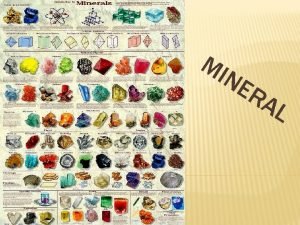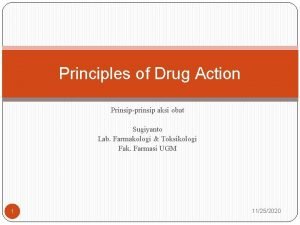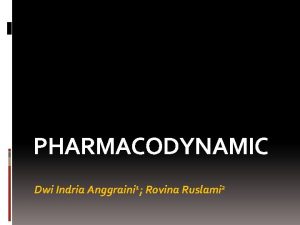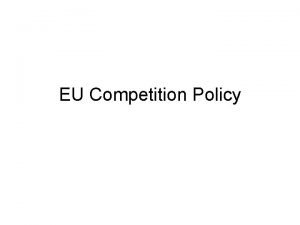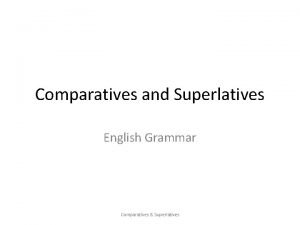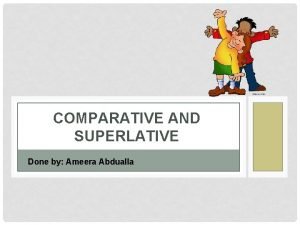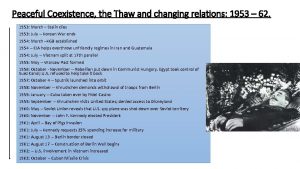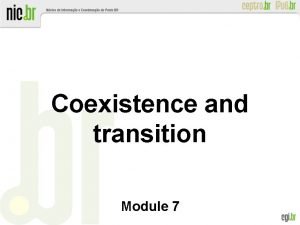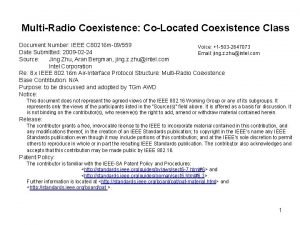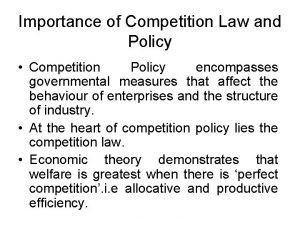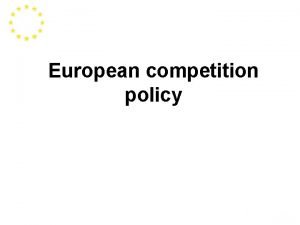TDIs and Competition Policy Antagonism or Peaceful CoExistence

















- Slides: 17

TDIs and Competition Policy: Antagonism or Peaceful Co-Existence Presentation at The Future of Trade Defence Instruments: Global Policy Trends and Legal Challenges Conference. François-Charles Laprévote March 31, 2017 clearygottlieb. com

I. EU Trade Defense Law and Competition Law: Key Concepts 2

Introduction to EU TDIs — History. Anti-dumping and competition law have similar origins • US • 1890 Sherman Act (antitrust) prohibited any restraint of trade or attempt to monopolize by groups or individuals • 1914 Clayton Act (antitrust) first captured concept of predatory pricing and price discrimination. • 1916 Anti-Dumping Act framed in classic antitrust language – forbids every “combination, conspiracy, trust, agreement or contract … intended to operate in restraint of lawful trade”; concept of predatory intent observed in “intent of destroying or injuring an industry in the United States”. • EU • 1957 Treaty of Rome (EEC): Specific goals included balanced trade and fair competition. • Chapter on Competition Rules specifically considers both competition policy and dumping practices (Article 85 – rules applicable to enterprises; Article 91 – dumping) — In practice, both systems have diverged, especially on price discrimination. 3

Implementation of Antitrust and Trade Defense – Divergences Anti-Dumping Antitrust Substantive/procedural concepts Only the Basic Anti-Dumping Regulation and the Guide on How to Draft AD Complaint Very detailed – numerous guidelines, working documents Timeframe 15 months No limitations besides rules on statute of limitations Cooperation with authorities No obligation to cooperate but Article 18 - “facts available” Parties obliged to cooperate – refusal may lead to fines Decision-making process Member States have power to reject Commission proposal Both Commission and national authorities may investigate; “Consultation” with national authorities purely advisory Judicial Review Imposition of duties subject to limited review Antidumping policy also constrained by WTO anti-dumping agreement Fines subject to full judicial review 4

Influence of Competition Concepts in EU AD policy 5

The Union interest test — Union interest test (Article 21, Basic Anti-Dumping Regulation) is a precaution taken by the EU to restrict the use of AD measures. It contains competition elements: 1. All interests at stake must be examined 2. Those interests must be balanced against each other – special consideration of “the need to eliminate the trade distorting effects of injurious dumping and to restore effective competition” (competition defense) — “Competition defense” has been raised in many cases by users, importers and exporters who argue that imposition of AD measures: • Might lead to monopolistic or oligopolistic position of the industry • Might reduce number of supply sources in EU by driving one or more exporters out of business • Euroalliages. To reject a challenge against refusal to renew duties, GC considered the “artificially high level” of prices resulting from imposition of measures, that had placed users at competitive disadvantage. • In other cases, competition-inspired arguments rejected by EU institutions; Bicycles – “temporary inconvenience” of higher prices generated by AD measures was less significant than negative consequences to jobs and activity 6

When Competition Invoked to Justify AD Measures Commission uses these arguments to defend imposition of AD measures: — Addressing market distortions. Prioritizing longer-term goal of restoring fair competition over consumers’ short-term price benefits. — Counterfactual scenario resulting in greater price increase. Refraining from imposing duties would lead to exit of EU producers from the market and ultimately result in less competition. — Dumped imports serve exclusionary purpose. In Television camera systems, Commission interpreted the dumping as a strategy to drive competitors out of the market. — AD duty not necessarily passed to end consumer. Sometimes there is no evidence that duties will be passed on, and, when product is a raw material, price is only small fraction of cost of the finished product. The duty therefore will likely not be passed on. — AD duty also benefits alternative importers. Restoring fair market conditions can also benefit alternative supply sources like non-dumped imports. — Potential entry. Commission considers potential entrants to mitigate risk that competition could be reduced by imposition of measures. — Efficiencies. Elimination of economically viable undertakings in order to ensure survival of one with higher production costs cannot be justified as aim is to enable a correct allocation of resources. — Effect on users. Commission considers impact on users’ ability to continue obtaining supplies. (Poudres spheriques) 7

Possible “abuse” of competition concepts in AD decisions — Applying “monopoly” or “dominant position” concepts to entire industries, sometimes composed of myriad exporters; e. g. “the monopoly of Chinese imports”. — Despite that, no detailed analysis of possible collusion or coordination between exporters and/or EU industry. — Circular reasoning: says nothing on whether AD measures likely to decrease competition further (through duopoly) or otherwise. — Debatable counterfactual scenarios • Crystalline silicon. Failing to impose duties would leave consumers with only 1 source of supply of modules. 8

Circumvention and Absorption — Circumvention procedures often at odds with competition objectives: • Less stringent requirements to launch a procedure compared with AD investigation (not necessary to demonstrate measures supported by majority of industry; not subject to WTO AD agreement) • Requirements to launch procedure less stringent than AD investigation: not necessary to demonstrate measures supported by majority of industry; not subject to WTO AD Agreement. • Results only in imposition of initial dumping duty even if duty is higher than dumping margin • Not subject to Union interest test – no assessment of competition conditions — Absorption. Purpose is to “absorb” (refrain from passing on) impact of duties on customers. • Parallels considerations of “sacrifice” in competition cases • Conduct considered predatory if it entails a “sacrifice” (loss) for the dominant undertaking, that it suffers deliberately. • Wanadoo Interactive. Sacrificed short-term profitability for vigorous penetration of the market. 9

Lesser Duty Rule and Market Economy Test — Lesser duty rule. Allows partial compensation of anti-competitive effects of AD proceedings • Prevents consumer from paying additional surcharge for EU industry inefficiencies (if normal value lower than non -injurious price level) • Level of duty should be set at the lowest rate, (comparing dumping margin and injury margin, i. e. difference between export price and non-injurious price level) • Attempts to remove only distortion of competition from dumping and not to completely close market to exporters. — Market economy test. Article 2(7)(c) Basic Regulation. • Exporters from non-market economies (NMEs) are subject to special treatment • Exporters from NMEs have to demonstrate they meet ME criteria and if not, normal value of the product determined based on price/cost from an “analogue country”. • ME criteria connected to competition concerns: decisions on prices, costs, are response to supply and demand, and not result of state interference; absence of distortions on production costs and financial situation of the company. — China. NME status at WTO “expired” on December 11, 2016. • New Regulation (2016/0351) contains “new” methodology has been proposed and is still awaiting decision from Parliament. • No more list of countries that would automatically be NMEs (in existing regulation, China is listed as an NME) • The term “NME” is not used – instead, term is “significantly distorted markets” 10

Impact of AD on Antitrust and Merger Control 11

Do AD cases facilitate cartels? — Theory: AD measures may reduce number of sellers on market and deter non-cartel members from attempting to enter. • E. g. Ferro-silicon cartel in Europe and US used AD duties to eliminate competition from five third-country importers. — Certain features of the AD procedure may favor collusion: • Rules on support by EU producers. • Exchanges of sensitive information among competitors. • Signaling behavior. • Price undertakings 12

Overlaps Between Periods of Cartels and Anti-Dumping Duties PRODUCTS PERIOD OF CARTEL PERIOD OF ANTIDUMPING DUTIES Sodium gluconate 1987 -1995 2010 -2015 PRODUCTS PERIOD OF CARTEL PERIOD OF ANTIDUMPING DUTIES Seamless pipes and tubes, of iron or nonalloy steel or steel 1990 -1999 Candles, tapers and the like/ Candle waxes 1993 -1998; 1997 -2002 2000 -2005; 2006 -2011 2009 -2014; 2011 -2016 1992 -2005 2009 -2014 Carbon and graphite Graphite electrode systems/ Graphite electrodes Specialty graphite 1988 -1999 1992 -1998 1993 -1998 2004 -2009 1993 -2002 1996 -2001 1996 -2002 2000 -2005 Carbonless paper Coated fine paper 1992 -1995 2011 -2016 Chloroprene rubber (CR) Rubber chemicals Synthetic rubber (BR and ESBR) Synthetic rubber (NBR) SBS thermoplastic rubbers Dynamic random access memories (DRAM) 1998 -2002 1990 -1995; 1993 -1997 Video tape reels/ Video tapes in cassettes Professional video tapes 1996 -2006 2000 -2005 1999 -2002 Television and computer monitor tubes Cathode-ray color television picture tubes Flat glass Solar glass 2004 -2005 2014 -2019 Citric acid 1991 -1995 2008 -2013; 2015 -2020 Refrigeration compressors Refrigerators (side-byside) compressors 2004 -2007 1989 -1994; 1991 -1996 2006 -2011 2008 -2010 13

Anti-Dumping and Abuse of Dominant Position — Case T-5/97, Industrie des Poudres Sphériques, para 213: “ recourse to a remedy in law and, in particular, participation by an undertaking in an investigation conducted by the community institutions cannot be deemed, of itself, to be contrary to Article 86 of the Treaty. In the present case, the anti-dumping procedure aims to re-establish undistorted competition in the market in the interest of the Community[…] To assert that mere recourse to such a procedure is, of itself, contrary to Article 86 of the treaty amounts to denying undertakings the right to avail themselves of legal instruments established in the interest of the Community” (emphasis added) — Does this entirely exclude an abuse based on anti-dumping proceedings? 14

Anti-dumping and merger control — Impact of anti-dumping duties on competitive assessment: • Market definition – e. g. Bluestar/Elkem • New/ potential entry: Osram/Sunny World — Anti-dumping and remedies – Ajinomoto/Orsan 15

Conclusion and Recommendations — There is a real need for improvement, both on substance and procedure, in coordinating both AD and competition policies. — Gradual policy alignment: • Assessing impact of measures on competition in systematic manner rather than on request from parties • Increasing use of economic tools • Systematically taking into account structure of market, in terms of supply (to measure risk of dominance) and demand (to determine countervailing power of customers) • Exercising caution in use of procedures that may result in anti-competitive outcomes, e. g. absorption, circumvention, price undertakings. • Additional sanctions for abuse of AD procedures in cartelization context? — More radical improvement at the international level: • Harmonizing competition law with AD mechanisms (or removing them) with other countries • Using FTAs as a possible avenue for negotiating interaction between trade defense and competition laws. 16

© 2017 Cleary Gottlieb Steen & Hamilton LLP. All rights reserved. Throughout this presentation, “Cleary Gottlieb” and the “firm” refer to Cleary Gottlieb Steen & Hamilton LLP and its affiliated entities in certain jurisdictions, and the term “offices” includes offices of those affiliated entities.
 Peaceful coexistence apush
Peaceful coexistence apush The coexistence of good and evil
The coexistence of good and evil Coexistence
Coexistence Bittitan archive migration
Bittitan archive migration Bittitan coexistence
Bittitan coexistence Mineral antagonism
Mineral antagonism Competitive antagonism
Competitive antagonism Competitive antagonism
Competitive antagonism Competitive antagonism
Competitive antagonism Perfect competition vs monopolistic competition
Perfect competition vs monopolistic competition Perfect competition vs monopolistic competition
Perfect competition vs monopolistic competition Market structures venn diagram
Market structures venn diagram Perfect competition vs monopolistic competition
Perfect competition vs monopolistic competition What is competition policy
What is competition policy Careful superlative
Careful superlative Adjective ending with er
Adjective ending with er Cornelia m. ruland and shirley m. moore
Cornelia m. ruland and shirley m. moore Big joe peaceful
Big joe peaceful





